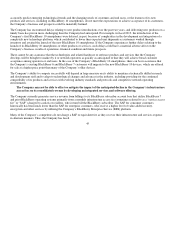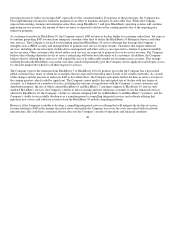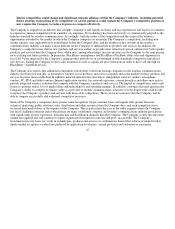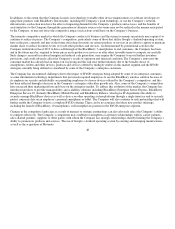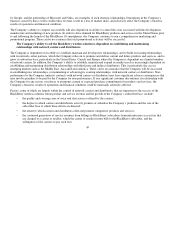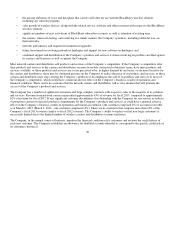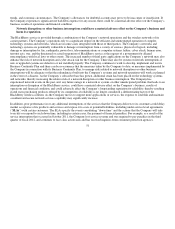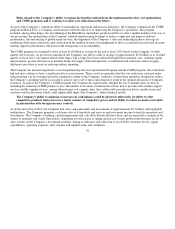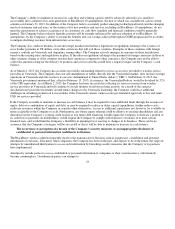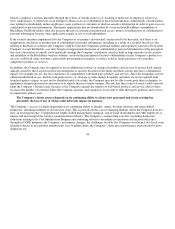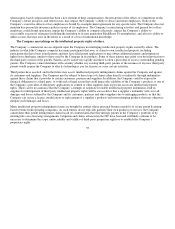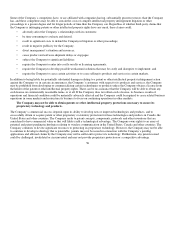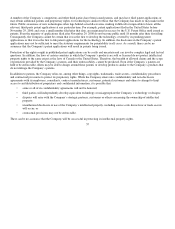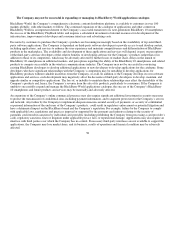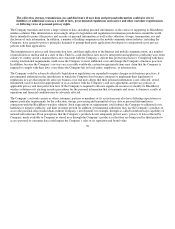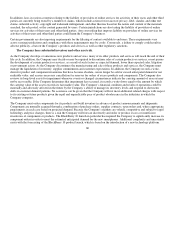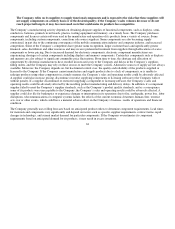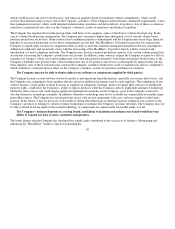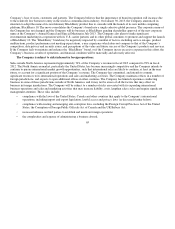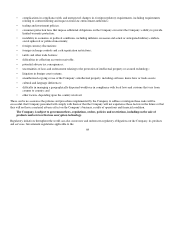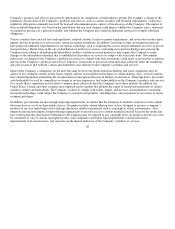Blackberry 2013 Annual Report Download - page 62
Download and view the complete annual report
Please find page 62 of the 2013 Blackberry annual report below. You can navigate through the pages in the report by either clicking on the pages listed below, or by using the keyword search tool below to find specific information within the annual report.
whom equity-based compensation has been a key element of their compensation), the perception of the effects of competition on the
Company’s future prospects, and other factors, may impact the Company’s ability to attract and retain employees. None of the
Company’s executive officers or key employees is bound by an employment agreement for any specific term. The Company does not
maintain key-person life insurance policies on any of its employees. The Company’s restructuring activities and general loss of key
employees could disrupt operations, impair the Company’s ability to compete effectively, impact the Company’s ability to
successfully execute its strategies (including the transition to its next generation BlackBerry 10 smartphones), and affect its ability to
address issues that may arise in the future as a result of a loss of institutional knowledge.
The Company may infringe on the intellectual property rights of others.
The Company’s commercial success depends upon the Company not infringing intellectual property rights owned by others. The
industry in which the Company competes has many participants that own, or claim to own, intellectual property, including
participants that have been issued patents and may have filed patent applications or may obtain additional patents and proprietary
rights for technologies similar to those used by the Company in its products. Some of these patents may grant very broad protection to
the third-party owners of the patents. Patents can be issued very rapidly and there is often a great deal of secrecy surrounding pending
patents. The Company cannot determine with certainty whether any existing third-party patents or the issuance of any new third-party
patents would require the Company to alter its technologies, pay for licenses or cease certain activities.
Third parties have asserted, and in the future may assert, intellectual property infringement claims against the Company and against
its customers and suppliers. The Company may be subject to these types of claims either directly or indirectly through indemnities
against these claims that it provides to certain customers, partners and suppliers. In addition, the Company could be exposed to
financial obligations to a third party, or to the risk of legal action that could impact the salability of the Company’s products, if one of
the Company’s providers of third-party applications or content or other suppliers fails to procure necessary intellectual property
rights. There can be no assurance that the Company’s attempts to negotiate favorable intellectual property indemnities with its
suppliers for infringement of third-party intellectual property rights will be successful or that a supplier’s indemnity will cover all
damages and losses suffered by the Company and its customers, partners and other suppliers due to infringing products, or that the
Company can secure a license, modification or replacement of a supplier’s products with non-infringing products that may otherwise
mitigate such damages and losses.
Many intellectual property infringement claims are brought by entities whose principal business model is to secure patent licensing-
based revenue from operating companies. As such entities do not typically generate their own products or services, the Company
cannot deter their patent infringement claims based on counterclaims that they infringe patents in the Company’s portfolio or by
entering into cross-licensing arrangements. Litigation and claims advanced in the ITC have been and will likely continue to be
necessary to determine the scope, enforceability and validity of third-party proprietary rights or to establish the Company’s
proprietary rights.
55


